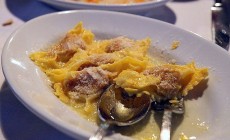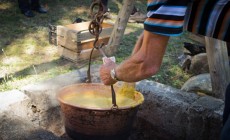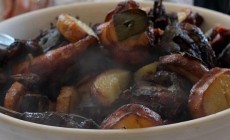Spits, game, boiled meat, but also lake-fish. And: ravioli, soups, mountain mushrooms, polenta, cheeses and sausages…
Brescian cooking has hundreds of dishes to offer in which the cooking traditions of the mountains, plain and lakes are mingled and all of which are accompanied by exquisite, high quality local D.O.C. wines.
Lakeside cuisine
This is mostly based on simple methods of preparing lake-fish. The Carp (“carpione”), that finds its habitat in Lake Garda, cooked with peas and tomato sauce, is still the unquestioned king of Garda cooking even if it is getting more difficult to find on restaurant menus.
Perch, bleak (cooked in onions), grilled “sardine” on Montisola and baked or stuffed tench on the shores of Iseo (in particular Clusane) are all delicious.
It is very difficult to identify typical Brescian cooking as local cuisine has freely borrowed from nearby provinces.
Typical is “casonsèi”, eaten in both Brescia and Bergamo provinces, large home-made ravioli filled with egg, seasoned cheese or ricotta (“puina”), spinach or meat, and seasoned with sage-flavoured butter.
 In the Brescian part of the Lombardy plain, “tortelli di zucca” are a speciality. They are a variant on the dish from Mantova and are tortelli pasta filled with pumpkin and macaroons. Another dish claimed by the Brescians, the Bergamaschi and the inhabitants of Valtellina is “polenta taragna” , named after the long stick (“tarai”) used to stir the large copper pots. This is dark corn-meal (polenta) made from yellow corn-flour and a handful of buckwheat into which fresh cheese such as “gorgonzola”, “robiola”, mountain “stracchino” (a soft cheese) are added at the end of the cooking with melted butter.
In the Brescian part of the Lombardy plain, “tortelli di zucca” are a speciality. They are a variant on the dish from Mantova and are tortelli pasta filled with pumpkin and macaroons. Another dish claimed by the Brescians, the Bergamaschi and the inhabitants of Valtellina is “polenta taragna” , named after the long stick (“tarai”) used to stir the large copper pots. This is dark corn-meal (polenta) made from yellow corn-flour and a handful of buckwheat into which fresh cheese such as “gorgonzola”, “robiola”, mountain “stracchino” (a soft cheese) are added at the end of the cooking with melted butter.
In Valsabbia, Bagolino cheese, “bagòss”, is used. Similarly, the origin is disputed of a wide variety of “polenta consa” (polenta with cheese added), often served on the lakes with “aole” , a small fish called bleak.
Brescian cooking has created an approach known, unfortunately, as “povertà”, literally poverty, referring both to the variety of ingredients used and the elaborateness of the preparation.
Surprisingly, the results are excellent and full of flavour.
 “Polenta” was once the daily food of the poor and eaten alone. Today it is still popular and eaten with meat or fish. Country dishes served with polenta are “cotiche in umido”, pork crackling in tomato sauce; “stufato”, beef-stew; “trippa”, tripe; “lepre in salmì”, salmì of hare; “coniglio”, rabbit; “capretto alla bresciana”, finely chopped pieces of kid sprinkled with white wine when three-quarters cooked; “manzo all’olio”, beef cooked in oil; “Uccellini scappati”, roulades of pork with sage; the choice Brescian dish in autumn. Also popular are “lumache alla bresciana”, snails cooked with spinach and grated parmesan cheese; “trippa alla camuna”, tripe prepared in minestrone with pinto beans; “rane alla camuna” frogs cooked in milk and butter; “frittate”, omelettes, “risotti” and “minestre”, soups made with herbs (“virzulì”) or mountain asparagus (“spàres de mont”) or rice and chicken giblets (the so-called “minestra sporca”, “dirty soup”), “radici amare”.
“Polenta” was once the daily food of the poor and eaten alone. Today it is still popular and eaten with meat or fish. Country dishes served with polenta are “cotiche in umido”, pork crackling in tomato sauce; “stufato”, beef-stew; “trippa”, tripe; “lepre in salmì”, salmì of hare; “coniglio”, rabbit; “capretto alla bresciana”, finely chopped pieces of kid sprinkled with white wine when three-quarters cooked; “manzo all’olio”, beef cooked in oil; “Uccellini scappati”, roulades of pork with sage; the choice Brescian dish in autumn. Also popular are “lumache alla bresciana”, snails cooked with spinach and grated parmesan cheese; “trippa alla camuna”, tripe prepared in minestrone with pinto beans; “rane alla camuna” frogs cooked in milk and butter; “frittate”, omelettes, “risotti” and “minestre”, soups made with herbs (“virzulì”) or mountain asparagus (“spàres de mont”) or rice and chicken giblets (the so-called “minestra sporca”, “dirty soup”), “radici amare”.

Also part of the Brescian cooking are the dishes based on stale bread which, instead of being throw away, is used as the main ingredient in tasty, filling meals. The best known is “zuppa di mariconde” (bread crumbs soaked in milk, mixed with egg and Parmesan, then cooked in chicken broth). Similar but served without broth are “gnocchi di pane”. Part of the same family of recipes is ” strangolapreti alla bresciana”, small gnocchi made of spinach, bread, egg and cheese, seasoned with melted butter, grated cheese and sage. Bread is also used in the standard filling for boiled chicken; it is so simple that it does not use either meat or eggs but only stale bread, broth, grated cheese, garlic, spices and nutmeg.
Stale bread is also used to prepare “capù senza ale”, small bundles are prepared of the leaves of a large savoy cabbage filled with grated bread, egg, grated cheese, parsley and spices which are then fried in butter, oil and tomato sauce.
Dessert
The most famous must be “bossolà”, related to the more famous Veronese cake, “pandoro”. It is made from a light pastry based on butter and eggs and baked in the shape of a dome with a hole in the middle. “Brescian biscuits” are light and delicate and can be found in old-fashioned bakers’ shop. “Scalitù” is a speciality of Valsabbia, prepared with corn-flour and figs. Not to be forgotten are “chisol”, “stricaganàse”, “barchitine del Signùr” and “persicata”, bars of peach jelly, which it is said were invented by a woman who wanted her son away at war to be reminded of the taste of the local peaches. As it was not possible to send fresh fruit which would go rotten during the journey, the canny lady invented what is still known as “persicata”.
Photo: thepinkpeppercorn, Luigi Mengato, motumboe
